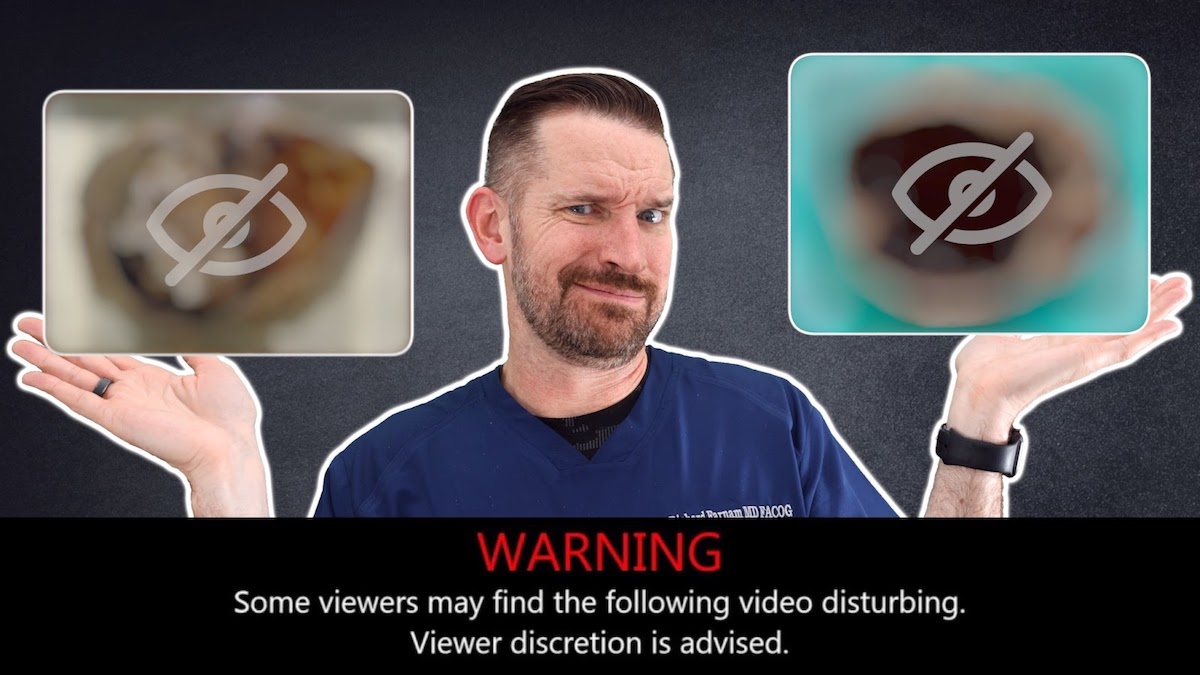Welcome back to the Dr. Rich channel. We all know and love Dr. Mike. He’s essentially the godfather of the medical Youtuber universe — and a brilliant clinician and doctor. However, he recently did a video on robotic surgery that brought us some issues that today we’re going to unpack. Make sure to stick around to the end to hear the truth about robotics in my 15 years’ experience with the technology.
Don’t have time to read this post? Watch the video here instead!
Doctor Rich:
All right, so we’ll get into it. The set-up here is Dr. Mike is watching and reacting to a video of a kid that invented his own surgical robot (as opposed to the da Vinci robot). I will watch and comment and react again on top of that reaction — given my experience performing 3,000 robotic surgeries.
Dr. Mike’s Video:
“And they don’t have any travel business. Instead of worrying about the surgical tools in a rail system, they move around anywhere on the operation table. I think the reason that the da Vinci robot doesn’t freely move around the patient is because you want it locked into place when you’re doing a minimally invasive procedure. You want it done in a specific area — I mean, like millimeters. Millimeters matter! And that’s actually one of the selling points of these robotic machines: They have a better range of motion than the human hand. They also are more precise. And when the surgeon actually looks inside with the camera, they can see 10x the magnification so they could be more accurate.”
Doctor Rich:
Okay. So here, he’s right on point: The da Vinci robot is designed to have very meticulous small movements to enhance the dexterity that the surgeon already has. So you could be a very skilled surgeon with your hands through an open incision or with a laparoscope, and once you get on the robotic platform, it’s computer-assisted surgery. So you’re doing the surgery. Your movements in space are translated to the little tiny robotic instruments into much smaller movements. So everything is more precise.
Dr. Mike’s Video:
[Watching the robot dissect the skin off a grape] “Look at that lighting system! What kind of surgeries do you think this — is like a prostate biopsy? Oh! They’re doing a little flap on a grape! It’s so gentle! Is this in slow motion or is that how fast the machine moves? I know minimally invasive surgery generally takes longer and the patient has to be under anesthesia longer. And sometimes that could make certain patients who want minimally invasive be told they aren’t good candidates because they can’t be under anesthesia for a long time. I’ve had patients be ruled out of robotic surgery just because of that.”
Doctor Rich:
So here, Mike is a little bit off. For every surgery and every modality that a surgeon’s going to learn, there’s going to be an associated learning curve. The core fundamental surgery that surgeons learn is how to do surgery through an open incision. That’s the way it’s been for centuries. The advances that have come about in laparoscopic surgery over the last 30, 40 years and then robotic surgery in the last 20 years are innovations that give patients better outcomes. But there’s a lot of technology, and it’s typically learned after you get your fundamental learning curve done with open surgery. And a lot of the literature that looks at that reflects surgeons doing cases in their learning curve during laparoscopic and robotic — as opposed to the same surgeons who have already become experts at open surgery. This is to say that when you actually compare apples to apples, the surgeons that are through their learning curve and are already experts in robotic or laparoscopic typically take equivalent time to do the surgeries. And oftentimes, it’s less than doing it through an open incision.
Dr. Mike’s Video:
“The little robot hands have such an amazing range of motion. It’s better than our human hands. And that’s what makes this super special as a type of technology. Because when you have to go into tight areas — into tight crevices — you need a really great range of motion. And remember when you’re looking at this with the naked eye, it’s hard to see where the grape begins and the skin ends.”
Doctor Rich:
So Dr. Mike is right on point here. The robot is these little tiny instruments (as opposed to your big hands!) inside tiny spaces, and it just makes the surgery easier. It makes it more efficient and better. In fact, there’s high-quality evidence (research) that shows that patients are more likely to end up with an open incision if you do the surgery laparoscopically as opposed to using the robot. So it basically empowers us to provide more of our patients with a minimally invasive outcome when that was the intention from the beginning.
Dr. Mike’s Video:
“I want to answer some of the top questions that I get from patients when they are either considering getting robotic surgery or someone has recommended it to them and they’re afraid.
Question #1: ‘Who does the surgery — the doctor or the robot?’
The answer is that the surgeons are controlling the robotic device a hundred percent.”
Doctor Rich:
So absolutely, this is a question that we get asked (not as much anymore, but certainly when the robotic platform first came out). Patients were afraid! They were like, “Well, I don’t want some robot to do the surgery. I want you to do the surgery!” But Dr. Mike is exactly correct. The surgeon sits down at a console and puts his head into a viewer, which gives him three-dimensional visualization within the operative field. He has two little joysticks that he holds, and those enable him to move the instrument arms around in the patient. But it is 100% a command control system. The surgeon does the movement, and the robot translates that movement into the smaller little tiny robot hands.
Dr. Mike’s Video:
“Question #2: ‘What are the differences between robotic surgery and open surgery?’
The difference between robotic surgery (which is considered a minimally invasive surgery) compared to open surgery is generally that robotic surgery has faster recovery times, less bleeding, and less side effects — and patients actually spend less time in the hospital as a result. Basically, you’re making smaller incisions, and at times, you don’t even need to make incisions (obviously, depending where the procedure is). Now, not every patient is a candidate for robotic surgery or minimally invasive surgery. So it needs to be discussed on an individual level. But something to also keep in mind: robotic surgery is really expensive (even when compared to other minimally invasive surgeries).”
Doctor Rich:
There’s a lot to unpack there, but for sure, Dr. Mike is absolutely right: Robotic is considered a minimally invasive type of surgery (along with a laparoscopic or a vaginal approach in gynecology) compared to open surgery. It has all the benefits that he mentioned: less blood loss, quicker recovery, less pain, a quicker return to work, and return to normal activities. So you would always want to do a minimally invasive surgery as opposed to an open surgery for all those benefits — and not least of which you don’t end up with a big scar on your abdomen. Instead, you have little tiny incisions.
Now for the question of cost. Certainly, the robot has a cost. The maintenance of the robot has a cost, the instruments have a cost. But you know… the argument of cost is kind of a tip-of-the-iceberg argument. People think of cost in terms of “How much does it cost to buy the robot?” But we have to realize that every major hospital in the entire country already has a robot, and that cost is already built into the system. If you look at a per case cost compared to other minimally invasive surgeries in an efficient program, it’s essentially cost neutral. The cost is already built in — the hospitals have purchased the robot.
The other cost thing that really needs to be considered when you look at robotics is that it was designed as a system to advance the reach of surgeons in converting open surgeries into minimally invasive surgeries. And effectively, it’s done that in every single specialty! 90% of urology, prostate surgeries are done robotically. 51% of all hysterectomies are now done robotically. And general surgery continues to grow and grow.
And it’s doing that because it’s allowing surgeons to take surgeries that would be big scars, lots of pain, long recovery — and converting those into minimally invasive surgery. So understand that the robot was designed to convert open surgeries to minimally invasive surgeries. And unquestionably, open surgery costs way more than robotics because the patient has to stay in the hospital for two, three… seven days! And every day in the hospital is $2,500 — while the entire cost of this surgery is $2,500! So the relevant comparator here is robotic versus open. And with robotic — you’re hands down saving money. Even when we look at robotics compared to other minimally invasive surgeries, in most cases, it ends up being relatively cost neutral if you’re not trying to amortize the cost of the robot into each of the surgeries.
Dr. Mike’s Video:
“Question #3: ‘Are there any procedures where robotic surgery doesn’t work?’
There are absolutely procedures where robotic surgery doesn’t work, and we have to tailor that to each individual patient. So when I have a patient that comes to me for a surgical clearance, we surgeons ask, “What is the cardiac status for the patient? Comorbidities? What is the patient taking medication-wise?” All of these things are factored in — in addition to the type of surgery that needs to be performed. Some surgeries just fare better as open surgeries than minimally invasive.”
Doctor Rich:
So Dr. Mike is correct. Some surgeries just don’t do as well and really aren’t amenable to a robotic (or even a minimally invasive) platform. An example of this would be trauma surgery where there’s an unknown process going on — like ongoing blood loss. The trauma surgeon just has to get in there (for instance, if there’s a gunshot wound) and get it fixed. But virtually all elective surgeries have that opportunity or ability to be either an open surgery or a minimally invasive surgery. Certainly, as he said, there are some cardiopulmonary issues (issues of ventilation during the surgery) since the surgeons have to be kind of tilted with their head down that limit robotic surgery. I can tell you from experience though: I have not scheduled an open surgery for 10 years. So all the surgeries I do are minimally invasive as they’re elective in my particular area of specialty in gynecology and urogynecology. There are very few exceptions and an expert’s hand but probably way fewer exceptions than you might think listening to that response.
Dr. Mike’s Video:
“Question #4: ‘Can any surgeon use the da Vinci machine?’
Any doctor or surgeon that’s trained on a da Vinci machine can use it, but you do need that level of training. You can’t just come on and start using it like Michael Reeves where you can come on and figure out how it works. Now, it’s more complicated than that and you absolutely need to be trained and certified.”
Doctor Rich:
So he’s exactly right — not everybody can do robotic surgery, but I do think that we need to unpack a little bit more. The maker of the surgical robot (Intuitive Surgical) actually has a very robust training program that’s required for surgeons to be able to use the technology. And I would say it’s more extensive than any other device maker or manufacturer on the market. A surgeon that wants to participate has to do an observation of a surgeon that’s already doing it. They have to do online training modules, then go and work on either an animal or in an inanimate lab. They then have to go get a case list of the equivalent surgeries from open, and a proctor surgeon has to actually come out and review how they do the surgery and has to sign off on it. And then, there’s a currency requirement, meaning that if they don’t do X number of surgeries every year on an ongoing basis, their equivalent privileges and credentials would then lapse and they’d be taken away. So I think that the introduction of surgical robotics has actually really bolstered our training and credentialing that we have as surgeons and keep all of us accountable.
Dr. Mike’s Video:
“Question #5: ‘Will robotic surgical systems make doctors obsolete?’
Doctors are humans, and humans need to treat humans. While there are certain things that we can allow the AI to do — help us better identify certain things on radiographic images, help us find information faster — they can not replace the mandatory human connection when treating the patient or the results of surgeries conducted.”
Doctor Rich:
So absolutely, the human connection can’t be replicated. I will say that there was a high-quality evidence study out of the UK that showed that AI and machine learning actually outperformed radiologists when it came to detecting breast cancer lesions. And this is only going to get more and more advanced. So for those specialties (like radiology and pathology that don’t have a huge element), there potentially is the possibility of a lot of those jobs being replaced by AI and machine learning in the near future. Now, the reality is that a surgeon has to learn the technique and they can get through a learning curve and they can do a procedure at the fastest that they can do it. But machines can actually be trained and taught to do simple tasks like suturing and actually put all of those things together. So, I mean, we are looking at (potentially in the next 10-15 years) robots being able to do most of the surgeries that we’re doing. The practical matter of it is that it will be used as an assistant technology to help the surgeon do better surgery.
Dr. Mike’s Video:
“Question #6: ‘Are the results of surgeries conducted with da Vinci worth the cost?’
This is one of the most important questions and why robotic surgery is actually a hotly contested subject. Remember, you have two different options for minimally invasive: laparoscopic and robotic. Robotic at times can be really expensive and not worth the benefits. So where do we go from here? Ideally, we want to lower the cost of these robotic surgeries so that they can replace laparoscopic procedures but not cost the healthcare system something like three to $5 billion a year. Also, there are certain things that can be happening in the near future where we can improve these systems and perhaps get the evidence to show that they’re better than the laparoscopic minimally invasive surgery.”
Doctor Rich:
Robotic cost is always going to be a hotly debated topic. The reality though is that this is an evolution of surgery — and this is where surgery is going. So in urology, as I mentioned, 90% of prostates are done robotically, and in gynecology, the majority (51%) of hysterectomies are now done robotically. General surgery is right on their tails. And it’s the physician-recognized benefit. All of the laparoscopic industry partners that are competing with Intuitive for these types of surgeries are all making their own surgical robots now because they see the value. They know this is the future, and they know this is where it’s going. The other thing to keep in mind is that as competition comes into the market (and also in general with all technology over time), cost comes down. And so we’re already functioning efficiently, comparatively superior to open surgeries, competitively, to minimally invasive surgeries.
Again, the majority of surgeries are being done robotically now. So this is the future, and more and more evidence like the studies that I’ve already talked about is going to come to light that continue to extol the benefits of robotic surgery. So that was a great video. I always learn stuff from watching Dr. Mike’s channel. This was a case where I thought we could use some additional data and some updating. Hopefully, you found it helpful and please share!




